1. Film / Foil Construction
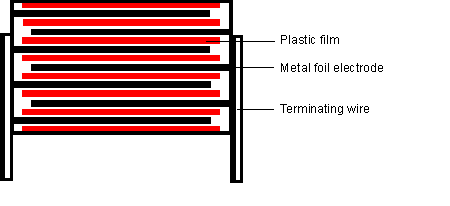
The film/foil construction is mainly used for capacitors with smaller capacitance (100pF through 0.1µF).
The advantage of this construction is the easy contactability of the metal foil electrodes and the good pulse strength.
A breakdown in the dielectric film of a F capacitor leads to an irreversible short circuit and thus, to failure.
To avoid breakdowns caused by weak spots in the dielectric, the insulating film chosen is always thicker than theoretically required by the values which are determined from the specific breakdown strength of the material. Films of less than 4 µm are not used for F capacitors because of their high proportion of weak points.
The necessity for thicker insulating film has an unfavorable effect on the size and the material used. In order to achieve a particular capacitance with thicker insulating film, the length of the band also has to be increased by the same amount. Thicker insulating film therefore squares the volume of the winding element.
A weak spot occurs, when depressions meet on the upper and lower surfaces of the film. The dielectric must then be at least thick enough to have just the required breakdown strength.
Advantage: High pulse loading capacity due to good contact of the terminating wires to the metal foil electrodes.
2. Metallized Construction
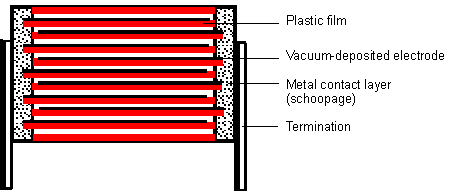
The metallized type of construction also makes it possible to produce wound capacitors with larger capacitance values in small sizes (~ 0.01µF through 100µF and larger). In the case of M capacitors, thin layers of aluminium (~ 0.03µm) are vacuum-deposited on the insulating film as conducting electrodes. In the case of a breakdown, the short circuit current causes the thin metal coating to evaporate around the point of failure, without reducing the quality of the dielectric. An insulating area is formed, the capacitor remains intact self-healing). The capacitance loss of a few pF which this causes, is of no importance.
With metallized capacitors, the breakdown strength of the insulating film can be used to the full. During the production of the capacitors the weak points are burnt out. This makes it possible to use the thinnest insulating films right down to < 1µm in thickness.
In contrast to the advantages of the small dimensions and the self-healing properties of metallized capacitors, there is the disadvantage of a limited current loading capacity as a result of the thin, vacuum-deposited metal layers.
Advantage: Construction with the most favorable capacitance/volume value.
3. Metallized Construction for Pulse Application
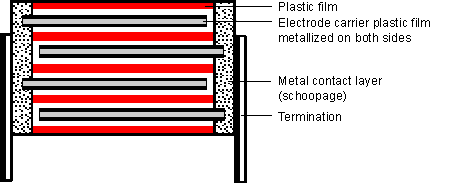 |
| Rated (DC) Voltage: 250Vdc、400Vdc |
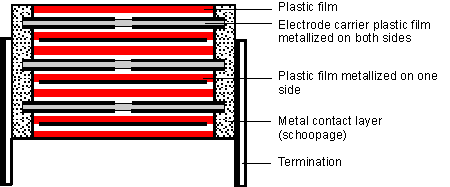 |
| Rated (AC) Voltage: 630Vdc、1000Vdc、1600Vdc、2000Vdc |
In order to counter the disadvantage of the limited current loading capacity of single-sided metallized capacitors,WINDAY has developed special metallized versions for high pulse applications, in which the electrodes are not directly metallized on the dielectric film. Aluminium is vacuum-deposited on both sides of a thin plastic film and this film is rolled up along with the insulating film as is the case with a film/foil capacitor.
With schoopage (metal flame spraying) and contacting, the two metal layers on the carrier film are joined together as a conductor. The carrier film is therefore in fieldfree space, its dielectric properties are of no importance, ('film in fieldfree space') and the self-healing process in breakdowns takes place on this film. Thanks to the metallization on both sides, this type has the same good self-healing properties as a capacitor which is metallized on one side only, the conducting capacity of a double thickness metallized layer and the advantage of better contacts.
These capacitors can stand up to very high pulse currents and have only a slightly larger volume than single-sided metallized capacitors. They offer high operating safety in critical applications.
Advantage:
High pulse loading capacity due to good contacting of the metal layers with schoopage.
Good self-healing properties thanks to the carrier film in fieldfree space.
4. Film/Foil Construction with Metallized Electrode Carrier Film
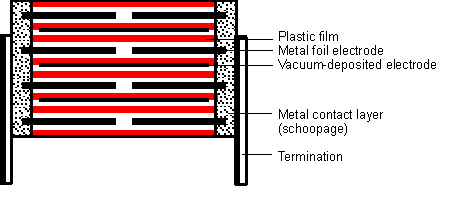
Due to its film/foil structure with metallized electrode carrier, this capacitor type is suitable for highest current loads. The capacitor is constructed as a series connection, the current carrying electrodes consist of two metal foils and a metallized carrier film as a 'floating electrode'.
After schoopage and bonding the wires are connected with all the edges of the winding element. The floating electrode only carries current through capacitive coupling. In this way, the advantage of self-healing (by means of the metallized floating electrode) is combined with the advantage of the exceptionally safe bonding of the metal foil. Thanks to the series connection, the value of the corona inception voltage is doubled.
Capacitors constructed in this way are suitable for very high rated currents with a maximum of operating safety.
Advantages:
Highest pulse loading capacity due to very good bonding (metal foil electrode and metallized electrode carrier film).
Good self-healing properties thanks to the metallized carrier film floating electrode.
Due to the series connection, the value of the corona inception voltage is doubled.
5. Self-healing Process in Metallized Capacitors
Even the best plastic films, like ceramic materials, are not free from pin-holes. However, in the case of metallized film capacitors it is possible to eliminate these faults by applying a much higher voltage than the rated voltage. This process is known as self-healing and practically makes a 'zero defect dielectric' possible.

Figure 1: Schematic representation of the self-healing process Figure 2: Isolated area after the self-healing process
The self-healing process is started by an electric breakdown, which takes about 10-8 secs. In the breakdown channel, the dielectric is transformed into a highly compressed plasma which is pushed out of the channel and presses the dielectric layers apart (figure 1).
In the spreading plasma, discharging continues over the metal electrodes. Temperatures of approximately 6000 K occur and insulated areas are formed around the original failure spot (figure 2). This self-healing process takes a few µsec and the discharging in the plasma has already ceased before a greater loss of voltage takes place. This quick extinction of the plasma is necessary to avoid further damage to the dielectric layer next to the point of failure.
The pressure between the layers must not be too great, so that the plasma can spread out from the breakdown channel quickly. Large parts of the plasma get into areas of low field strength.
The flawless course of the self-healing process depends on the thickness of the metallization, on the chemical composition and on the rate of the applied voltage; here, apart from the chemical composition, the production conditions have to provide the prerequisites for optimum self-healing.
Self-healing behaviour as a quality standard.